Happy birthday, Jane Langton.
Jane Langton, the creator of detective and scholar Homer Kelly, turns 84 today. She published her first novel, a children's book, in 1961. Notable books in her long career include the Edgar-nominated Emily Dickinson Is Dead (1984), the Edgar-nominated The Diamond in the Window (1962), and Steeplechase (2005).
Featuring History of Mystery/Detective Fiction and Other Literary Ramblings of Elizabeth Foxwell
Saturday, December 30, 2006
The Firsts.
In the rush to compile "Best Mysteries of 2006" lists, the first mystery novel often is overlooked. Here are three that I enjoyed in 2006:
In the rush to compile "Best Mysteries of 2006" lists, the first mystery novel often is overlooked. Here are three that I enjoyed in 2006:
- Murder 101, by Maggie Barbieri (St. Martin's). A lively academic mystery with a young professor and bon mots such as "Our school has a motto: Keep your alumni close and your rich alumni closer."
- Billy Boyle, by James R. Benn (Soho). An interesting look at the Norwegian contribution to WWII with a Boston Irish cop-turned-soldier who is related to General Eisenhower.
- Still Life, by Louise Penny (St. Martin's). A wise and often lyrical mystery set in Quebec that involves the murder of an artist and its effect on a small town.
Thursday, December 28, 2006
Submitted for your approval...
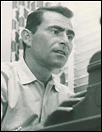 Happy belated birthday to the creator of the "Twilight Zone," Rod Serling, born on December 25, 1924. He died in 1975. His numerous accomplishments include screenplays for "Patterns," "Requiem for a Heavyweight," "Seven Days in May," and "Planet of the Apes."
Happy belated birthday to the creator of the "Twilight Zone," Rod Serling, born on December 25, 1924. He died in 1975. His numerous accomplishments include screenplays for "Patterns," "Requiem for a Heavyweight," "Seven Days in May," and "Planet of the Apes."
Rod Serling is one of my personal writing heroes for his crackling dialogue, twist endings, and superb handling of dramatic situations. Watching TZ now reveals the rampant fears of nuclear war and of technology taking over man. One favorite episode of mine (written by Serling) is "Twenty-two," in which a hospital patient has a recurring nightmare of following a figure down empty corridors to Room 22, and a gothic horror of a nurse emerges and says, "Room for one more, honey."
Room 22 is the morgue.
Do-do-do-doo...
To hear Serling deny in an interview with Mike Wallace that he would not engage in social issues in TZ is to laugh. As a teacher, he encouraged numerous fledgling writers, including mystery authors Sharan Newman and Sue Henry.
You can listen to clips from the Wallace interview and "Submitted for Your Approval," the "American Masters" program on Serling, here. Join the effort to put Serling on a U.S. postage stamp here.
 Happy belated birthday to the creator of the "Twilight Zone," Rod Serling, born on December 25, 1924. He died in 1975. His numerous accomplishments include screenplays for "Patterns," "Requiem for a Heavyweight," "Seven Days in May," and "Planet of the Apes."
Happy belated birthday to the creator of the "Twilight Zone," Rod Serling, born on December 25, 1924. He died in 1975. His numerous accomplishments include screenplays for "Patterns," "Requiem for a Heavyweight," "Seven Days in May," and "Planet of the Apes."Rod Serling is one of my personal writing heroes for his crackling dialogue, twist endings, and superb handling of dramatic situations. Watching TZ now reveals the rampant fears of nuclear war and of technology taking over man. One favorite episode of mine (written by Serling) is "Twenty-two," in which a hospital patient has a recurring nightmare of following a figure down empty corridors to Room 22, and a gothic horror of a nurse emerges and says, "Room for one more, honey."
Room 22 is the morgue.
Do-do-do-doo...
To hear Serling deny in an interview with Mike Wallace that he would not engage in social issues in TZ is to laugh. As a teacher, he encouraged numerous fledgling writers, including mystery authors Sharan Newman and Sue Henry.
You can listen to clips from the Wallace interview and "Submitted for Your Approval," the "American Masters" program on Serling, here. Join the effort to put Serling on a U.S. postage stamp here.
Monday, December 18, 2006
Book TV.
I'm a fan of C-Span's Book TV (although I'm partial to the history rather than the more politically oriented programs). This weekend's schedule included a look behind the New York Times Book Review with editor Sam Tenenhaus, copy editors, and other assorted staff, and I'm happy to say that some of their desks look worse than mine. Be sure to look at the entire room filled with ARCs that the NYTBR is not going to review.
Go here to watch online.
I'm a fan of C-Span's Book TV (although I'm partial to the history rather than the more politically oriented programs). This weekend's schedule included a look behind the New York Times Book Review with editor Sam Tenenhaus, copy editors, and other assorted staff, and I'm happy to say that some of their desks look worse than mine. Be sure to look at the entire room filled with ARCs that the NYTBR is not going to review.
Go here to watch online.
Wednesday, November 22, 2006
Happy birthday, Robert Barnard.
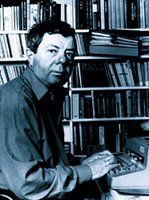 Diamond Dagger recipient Robert Barnard turns 70 on November 23rd. Maggie Topkis at Felony & Mayhem Press has recently reissued his Out of the Blackout, and his latest novel from Scribner is Dying Flames.
Diamond Dagger recipient Robert Barnard turns 70 on November 23rd. Maggie Topkis at Felony & Mayhem Press has recently reissued his Out of the Blackout, and his latest novel from Scribner is Dying Flames.
My favorite Barnard novels are A Scandal in Belgravia (with its superb twist ending) and Death of a Mystery Writer. In my interview with Barnard for "It's a Mystery," he revealed the model for the simply dreadful individual who gets (deservedly) bumped off in Death of a Mystery Writer: Evelyn Waugh.
Photo credit: Noel Barnard
 Diamond Dagger recipient Robert Barnard turns 70 on November 23rd. Maggie Topkis at Felony & Mayhem Press has recently reissued his Out of the Blackout, and his latest novel from Scribner is Dying Flames.
Diamond Dagger recipient Robert Barnard turns 70 on November 23rd. Maggie Topkis at Felony & Mayhem Press has recently reissued his Out of the Blackout, and his latest novel from Scribner is Dying Flames.My favorite Barnard novels are A Scandal in Belgravia (with its superb twist ending) and Death of a Mystery Writer. In my interview with Barnard for "It's a Mystery," he revealed the model for the simply dreadful individual who gets (deservedly) bumped off in Death of a Mystery Writer: Evelyn Waugh.
Photo credit: Noel Barnard
Saturday, November 18, 2006
Dear Author.
I was reading something in the blogosphere that mentioned fan mail to authors, and it reminded me of the first time I sent a fan letter to a writer.
 The recipient was George C. Chesbro, and the book was Shadow of a Broken Man (1977), in which he introduced Robert "Mongo" Frederickson, dwarf, former circus performer, genius criminologist, and PI. I was a teenager at the time, gobbling up Christie, Queen, Stout, and numerous other mystery authors, and I greatly enjoyed Mongo's considerable talents and his touching relationship with his brother. In those pre-email days, I sent off a letter in care of the publisher stating how much I liked the book and that I tended to forget that Mongo was a dwarf because of his many skills. How startled I was to receive a postcard from Chesbro, telling me "Alas, like the rest of us, Mongo has to manage with what he has" and a little about the next book in the series (City of Whispering Stone). Touched that Chesbro had taken the time to respond, I kept the postcard for years.
The recipient was George C. Chesbro, and the book was Shadow of a Broken Man (1977), in which he introduced Robert "Mongo" Frederickson, dwarf, former circus performer, genius criminologist, and PI. I was a teenager at the time, gobbling up Christie, Queen, Stout, and numerous other mystery authors, and I greatly enjoyed Mongo's considerable talents and his touching relationship with his brother. In those pre-email days, I sent off a letter in care of the publisher stating how much I liked the book and that I tended to forget that Mongo was a dwarf because of his many skills. How startled I was to receive a postcard from Chesbro, telling me "Alas, like the rest of us, Mongo has to manage with what he has" and a little about the next book in the series (City of Whispering Stone). Touched that Chesbro had taken the time to respond, I kept the postcard for years.
We tend to forget the impact that books can have beyond their entertainment value. I think of the fan who told Anne Perry that her novels helped her through ovarian cancer. I think of a woman who was choosing books on tape in the library for a bedridden elderly person whose greatest pleasure was listening to mysteries. I think of the 10-year-old fan of Elizabeth Peters whose mother helped her to make a toolbelt so she could "play Amelia Peabody" in the backyard. I myself have received some kind emails about my own work, invariably prefaced by "I hope I'm not bothering you." I think of the entire community out there, readers and writers, in ongoing, dynamic, often silent dialogue with each other, many outside the world of the Internet, and am staggered.
I was reading something in the blogosphere that mentioned fan mail to authors, and it reminded me of the first time I sent a fan letter to a writer.
 The recipient was George C. Chesbro, and the book was Shadow of a Broken Man (1977), in which he introduced Robert "Mongo" Frederickson, dwarf, former circus performer, genius criminologist, and PI. I was a teenager at the time, gobbling up Christie, Queen, Stout, and numerous other mystery authors, and I greatly enjoyed Mongo's considerable talents and his touching relationship with his brother. In those pre-email days, I sent off a letter in care of the publisher stating how much I liked the book and that I tended to forget that Mongo was a dwarf because of his many skills. How startled I was to receive a postcard from Chesbro, telling me "Alas, like the rest of us, Mongo has to manage with what he has" and a little about the next book in the series (City of Whispering Stone). Touched that Chesbro had taken the time to respond, I kept the postcard for years.
The recipient was George C. Chesbro, and the book was Shadow of a Broken Man (1977), in which he introduced Robert "Mongo" Frederickson, dwarf, former circus performer, genius criminologist, and PI. I was a teenager at the time, gobbling up Christie, Queen, Stout, and numerous other mystery authors, and I greatly enjoyed Mongo's considerable talents and his touching relationship with his brother. In those pre-email days, I sent off a letter in care of the publisher stating how much I liked the book and that I tended to forget that Mongo was a dwarf because of his many skills. How startled I was to receive a postcard from Chesbro, telling me "Alas, like the rest of us, Mongo has to manage with what he has" and a little about the next book in the series (City of Whispering Stone). Touched that Chesbro had taken the time to respond, I kept the postcard for years.We tend to forget the impact that books can have beyond their entertainment value. I think of the fan who told Anne Perry that her novels helped her through ovarian cancer. I think of a woman who was choosing books on tape in the library for a bedridden elderly person whose greatest pleasure was listening to mysteries. I think of the 10-year-old fan of Elizabeth Peters whose mother helped her to make a toolbelt so she could "play Amelia Peabody" in the backyard. I myself have received some kind emails about my own work, invariably prefaced by "I hope I'm not bothering you." I think of the entire community out there, readers and writers, in ongoing, dynamic, often silent dialogue with each other, many outside the world of the Internet, and am staggered.
Monday, November 13, 2006
Happy birthday, Vera Caspary.
 Vera Caspary, author of famed noir novel Laura and a talented screenwriter (A Letter to Three Wives, 1949), was born on November 13, 1899. She died in 1987. New paperback editions of Laura and her novel Bedelia are available from Feminist Press, and a play version of Laura is now running through November 18th at Chatauqua Playhouse in Carmichael, CA (near Sacramento).
Vera Caspary, author of famed noir novel Laura and a talented screenwriter (A Letter to Three Wives, 1949), was born on November 13, 1899. She died in 1987. New paperback editions of Laura and her novel Bedelia are available from Feminist Press, and a play version of Laura is now running through November 18th at Chatauqua Playhouse in Carmichael, CA (near Sacramento).
According to A. B. Emrys (see her article "Laura, Vera, and Wilkie" in Clues: A Journal of Detection, spring 2005), Caspary was influenced by Wilkie Collins's The Woman in White and The Moonstone as she wrote first a screenplay treatment of Laura, then a full-fledged novel. Further information on Caspary may be found in her autobiography The Secrets of Grown-ups (McGraw-Hill, 1979).
 Vera Caspary, author of famed noir novel Laura and a talented screenwriter (A Letter to Three Wives, 1949), was born on November 13, 1899. She died in 1987. New paperback editions of Laura and her novel Bedelia are available from Feminist Press, and a play version of Laura is now running through November 18th at Chatauqua Playhouse in Carmichael, CA (near Sacramento).
Vera Caspary, author of famed noir novel Laura and a talented screenwriter (A Letter to Three Wives, 1949), was born on November 13, 1899. She died in 1987. New paperback editions of Laura and her novel Bedelia are available from Feminist Press, and a play version of Laura is now running through November 18th at Chatauqua Playhouse in Carmichael, CA (near Sacramento).According to A. B. Emrys (see her article "Laura, Vera, and Wilkie" in Clues: A Journal of Detection, spring 2005), Caspary was influenced by Wilkie Collins's The Woman in White and The Moonstone as she wrote first a screenplay treatment of Laura, then a full-fledged novel. Further information on Caspary may be found in her autobiography The Secrets of Grown-ups (McGraw-Hill, 1979).
Saturday, November 11, 2006
Happy birthday, Anna Katharine Green.
 Often dubbed "the mother of detective fiction," pioneering American mystery author Anna Katharine Green was born on November 11, 1846. She died in 1935 and is buried in Buffalo.
Often dubbed "the mother of detective fiction," pioneering American mystery author Anna Katharine Green was born on November 11, 1846. She died in 1935 and is buried in Buffalo.
Her bestselling novel The Leavenworth Case (1878) has been taught in law schools to illustrate the deceptiveness of circumstantial evidence. I'm particularly fond of her books featuring intrepid spinster sleuth Amelia Butterworth (That Affair Next Door [1897], Lost Man's Lane [1898], and The Circular Study [1900]) and The Golden Slipper and Other Problems for Violet Strange (1915), in which Strange investigates cases in her New York social circle (I like the case where Strange appears at the crime scene in a ballgown--not exactly the wear we expect of a detective). Arthur Conan Doyle, Mary Roberts Rinehart, and Agatha Christie were all avid Green fans.
 Often dubbed "the mother of detective fiction," pioneering American mystery author Anna Katharine Green was born on November 11, 1846. She died in 1935 and is buried in Buffalo.
Often dubbed "the mother of detective fiction," pioneering American mystery author Anna Katharine Green was born on November 11, 1846. She died in 1935 and is buried in Buffalo.Her bestselling novel The Leavenworth Case (1878) has been taught in law schools to illustrate the deceptiveness of circumstantial evidence. I'm particularly fond of her books featuring intrepid spinster sleuth Amelia Butterworth (That Affair Next Door [1897], Lost Man's Lane [1898], and The Circular Study [1900]) and The Golden Slipper and Other Problems for Violet Strange (1915), in which Strange investigates cases in her New York social circle (I like the case where Strange appears at the crime scene in a ballgown--not exactly the wear we expect of a detective). Arthur Conan Doyle, Mary Roberts Rinehart, and Agatha Christie were all avid Green fans.
"I . . . realized that it would never do for me to lose my wits in the presence of a man who had none too many of his own."---Amelia Butterworth, That Affair Next Door
Wednesday, November 08, 2006
Fall 06 CLUES published.
 The fall 2006 issue of Clues: A Journal of Detection has been published, which is part 1 of a two-part issue on Victorian detective fiction. Articles focus on Mary Elizabeth Braddon, Wilkie Collins, Revelations of a Lady Detective (attributed to W.S. Hayward), Sherlock Holmes, Arthur Machen, Edgar Allan Poe, and "the detective fiction of female adolescent violence." The issue's table of contents and more information about the journal may be found here.
The fall 2006 issue of Clues: A Journal of Detection has been published, which is part 1 of a two-part issue on Victorian detective fiction. Articles focus on Mary Elizabeth Braddon, Wilkie Collins, Revelations of a Lady Detective (attributed to W.S. Hayward), Sherlock Holmes, Arthur Machen, Edgar Allan Poe, and "the detective fiction of female adolescent violence." The issue's table of contents and more information about the journal may be found here.
 The fall 2006 issue of Clues: A Journal of Detection has been published, which is part 1 of a two-part issue on Victorian detective fiction. Articles focus on Mary Elizabeth Braddon, Wilkie Collins, Revelations of a Lady Detective (attributed to W.S. Hayward), Sherlock Holmes, Arthur Machen, Edgar Allan Poe, and "the detective fiction of female adolescent violence." The issue's table of contents and more information about the journal may be found here.
The fall 2006 issue of Clues: A Journal of Detection has been published, which is part 1 of a two-part issue on Victorian detective fiction. Articles focus on Mary Elizabeth Braddon, Wilkie Collins, Revelations of a Lady Detective (attributed to W.S. Hayward), Sherlock Holmes, Arthur Machen, Edgar Allan Poe, and "the detective fiction of female adolescent violence." The issue's table of contents and more information about the journal may be found here.
Tuesday, October 31, 2006
Happy birthday, Dick Francis, H.R.F. Keating, and Kinky Friedman.
 Former jockey for the late Queen Mother and accomplished author Dick Francis turns 86 today; distinguished critic H.R.F. Keating (at left), the creator of Inspector Ghote, turns 80; and mystery writer and Texas gubernatorial hopeful Kinky Friedman, aka the Kinkster, turns 62.
Former jockey for the late Queen Mother and accomplished author Dick Francis turns 86 today; distinguished critic H.R.F. Keating (at left), the creator of Inspector Ghote, turns 80; and mystery writer and Texas gubernatorial hopeful Kinky Friedman, aka the Kinkster, turns 62.
 Former jockey for the late Queen Mother and accomplished author Dick Francis turns 86 today; distinguished critic H.R.F. Keating (at left), the creator of Inspector Ghote, turns 80; and mystery writer and Texas gubernatorial hopeful Kinky Friedman, aka the Kinkster, turns 62.
Former jockey for the late Queen Mother and accomplished author Dick Francis turns 86 today; distinguished critic H.R.F. Keating (at left), the creator of Inspector Ghote, turns 80; and mystery writer and Texas gubernatorial hopeful Kinky Friedman, aka the Kinkster, turns 62.
Saturday, October 28, 2006
Happy birthday, Simon Brett and Anne Perry.
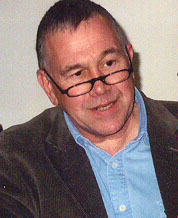 Two British authors celebrate birthdays today. The multitalented Simon Brett (radio producer and author of many mysteries, including the recent The Stabbing in the Stables) turns 61. One of his novels, A Shock to the System, was made into a 1990 film with Michael Caine. You can listen to an excerpt of Simon reading from Murder in the Museum (where he does all the characters' voices) from my radio show "It's a Mystery" here.
Two British authors celebrate birthdays today. The multitalented Simon Brett (radio producer and author of many mysteries, including the recent The Stabbing in the Stables) turns 61. One of his novels, A Shock to the System, was made into a 1990 film with Michael Caine. You can listen to an excerpt of Simon reading from Murder in the Museum (where he does all the characters' voices) from my radio show "It's a Mystery" here.
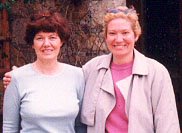 The energetic Anne Perry celebrates her 68th birthday today. Author of two Victorian mystery series (most recently, Dark Assassin), a WWI series (most recently, Angels in the Gloom), and numerous short stories and novellas, she just sold a standalone to Ballantine (according to Publishers Weekly) that will deal with a woman in the Byzantine empire seeking to exonerate her condemned brother. (Photo credits: Brett: Jason David Hall; Perry & Foxwell: Dean James)
The energetic Anne Perry celebrates her 68th birthday today. Author of two Victorian mystery series (most recently, Dark Assassin), a WWI series (most recently, Angels in the Gloom), and numerous short stories and novellas, she just sold a standalone to Ballantine (according to Publishers Weekly) that will deal with a woman in the Byzantine empire seeking to exonerate her condemned brother. (Photo credits: Brett: Jason David Hall; Perry & Foxwell: Dean James)
 Two British authors celebrate birthdays today. The multitalented Simon Brett (radio producer and author of many mysteries, including the recent The Stabbing in the Stables) turns 61. One of his novels, A Shock to the System, was made into a 1990 film with Michael Caine. You can listen to an excerpt of Simon reading from Murder in the Museum (where he does all the characters' voices) from my radio show "It's a Mystery" here.
Two British authors celebrate birthdays today. The multitalented Simon Brett (radio producer and author of many mysteries, including the recent The Stabbing in the Stables) turns 61. One of his novels, A Shock to the System, was made into a 1990 film with Michael Caine. You can listen to an excerpt of Simon reading from Murder in the Museum (where he does all the characters' voices) from my radio show "It's a Mystery" here. The energetic Anne Perry celebrates her 68th birthday today. Author of two Victorian mystery series (most recently, Dark Assassin), a WWI series (most recently, Angels in the Gloom), and numerous short stories and novellas, she just sold a standalone to Ballantine (according to Publishers Weekly) that will deal with a woman in the Byzantine empire seeking to exonerate her condemned brother. (Photo credits: Brett: Jason David Hall; Perry & Foxwell: Dean James)
The energetic Anne Perry celebrates her 68th birthday today. Author of two Victorian mystery series (most recently, Dark Assassin), a WWI series (most recently, Angels in the Gloom), and numerous short stories and novellas, she just sold a standalone to Ballantine (according to Publishers Weekly) that will deal with a woman in the Byzantine empire seeking to exonerate her condemned brother. (Photo credits: Brett: Jason David Hall; Perry & Foxwell: Dean James)
Saturday, October 14, 2006
Notable Oct 15 Birthdays
October 15th sure is a popular day for birthdays in mysterydom:
October 15th sure is a popular day for birthdays in mysterydom:
- Ed McBain/Evan Hunter, of 87th Precinct and Blackboard Jungle fame: b. Oct 15, 1926, who left us in 2005.
- Elizabeth Daly, the creator of sleuth and bibliophile Henry Gamadge: b. Oct 15, 1878 (d. 1967).
- Art critic and Smart Set editor Willard Huntington Wright, better known as S.S. Van Dine, the creator of detective Philo Vance, b. Oct 15, 1888 (d. 1939).
Tuesday, October 10, 2006
Happy birthday, Nora Roberts/J. D. Robb
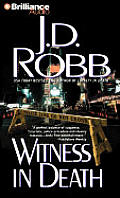 Born in Maryland in 1950, bestselling romance author Nora Roberts celebrates her 56th birthday today.
Born in Maryland in 1950, bestselling romance author Nora Roberts celebrates her 56th birthday today.
Under the pseudonym J. D. Robb, Roberts writes a mystery series set in the future featuring lieutenant Eve Dallas. I'm particularly fond of Witness in Death because of its bitchy theater setting and a sure-fire hook: an actor dies on stage during a performance, where the entire audience, including Dallas, is witness to the murder. Roberts knows how to tell a story, and the reader is guaranteed a good time with any of her books.
 Born in Maryland in 1950, bestselling romance author Nora Roberts celebrates her 56th birthday today.
Born in Maryland in 1950, bestselling romance author Nora Roberts celebrates her 56th birthday today.Under the pseudonym J. D. Robb, Roberts writes a mystery series set in the future featuring lieutenant Eve Dallas. I'm particularly fond of Witness in Death because of its bitchy theater setting and a sure-fire hook: an actor dies on stage during a performance, where the entire audience, including Dallas, is witness to the murder. Roberts knows how to tell a story, and the reader is guaranteed a good time with any of her books.
Monday, October 02, 2006
Happy birthday, Graham Greene.
 Today marks what would have been Graham Greene's 102nd birthday (he died in 1991).
Today marks what would have been Graham Greene's 102nd birthday (he died in 1991).
Greene distinguished between what he called his "entertainments" (e.g., Stamboul Train, A Gun for Sale, Our Man in Havana, and The Confidential Agent) and his more mainstream novels (e.g., Brighton Rock), although the latter works often possessed crime elements.
Noted Simon & Schuster editor Michael Korda observed Greene at work and makes some interesting comments on Greene's work habits in his book Another Life: A Memoir of Other People (1999). There's a new book out on Greene: Characters and Plots in the Fiction of Graham Greene by Robert L. Gale.
Go here for excerpts from a 1969 BBC interview with Greene. For those wild for zither music and that mysterious character Harry Lime, I'll be broadcasting a radio production of Greene's The Third Man on my radio program "It's a Mystery" today at 11 AM ET. It stars Joseph Cotten and Evelyn Keyes. The program is Webcast here.
 Today marks what would have been Graham Greene's 102nd birthday (he died in 1991).
Today marks what would have been Graham Greene's 102nd birthday (he died in 1991).Greene distinguished between what he called his "entertainments" (e.g., Stamboul Train, A Gun for Sale, Our Man in Havana, and The Confidential Agent) and his more mainstream novels (e.g., Brighton Rock), although the latter works often possessed crime elements.
Noted Simon & Schuster editor Michael Korda observed Greene at work and makes some interesting comments on Greene's work habits in his book Another Life: A Memoir of Other People (1999). There's a new book out on Greene: Characters and Plots in the Fiction of Graham Greene by Robert L. Gale.
Go here for excerpts from a 1969 BBC interview with Greene. For those wild for zither music and that mysterious character Harry Lime, I'll be broadcasting a radio production of Greene's The Third Man on my radio program "It's a Mystery" today at 11 AM ET. It stars Joseph Cotten and Evelyn Keyes. The program is Webcast here.
Saturday, September 30, 2006
Happy dual birthday, Truman Capote/Michael Innes.
Truman Capote, the author of In Cold Blood, would have turned 82 today. He died in 1984. A new film, Infamous, starring Toby Jones as Capote in yet another examination of the genesis of In Cold Blood, is scheduled for release on October 13th.
 British author Michael Innes, aka J. I. M. Stewart, would have celebrated his 100th birthday today. He died in 1994. In a writing career that spanned more than 50 years, university professor Stewart wrote numerous academic, fiction, and radio works, including a mystery series featuring Scotland Yard inspector John Appleby. These titles include Hamlet, Revenge!, Appleby's End, and A Family Affair.
British author Michael Innes, aka J. I. M. Stewart, would have celebrated his 100th birthday today. He died in 1994. In a writing career that spanned more than 50 years, university professor Stewart wrote numerous academic, fiction, and radio works, including a mystery series featuring Scotland Yard inspector John Appleby. These titles include Hamlet, Revenge!, Appleby's End, and A Family Affair.
Photo credit: Fay Godwin
Truman Capote, the author of In Cold Blood, would have turned 82 today. He died in 1984. A new film, Infamous, starring Toby Jones as Capote in yet another examination of the genesis of In Cold Blood, is scheduled for release on October 13th.
 British author Michael Innes, aka J. I. M. Stewart, would have celebrated his 100th birthday today. He died in 1994. In a writing career that spanned more than 50 years, university professor Stewart wrote numerous academic, fiction, and radio works, including a mystery series featuring Scotland Yard inspector John Appleby. These titles include Hamlet, Revenge!, Appleby's End, and A Family Affair.
British author Michael Innes, aka J. I. M. Stewart, would have celebrated his 100th birthday today. He died in 1994. In a writing career that spanned more than 50 years, university professor Stewart wrote numerous academic, fiction, and radio works, including a mystery series featuring Scotland Yard inspector John Appleby. These titles include Hamlet, Revenge!, Appleby's End, and A Family Affair.Photo credit: Fay Godwin
Friday, September 29, 2006
Happy birthday, Barbara Mertz.
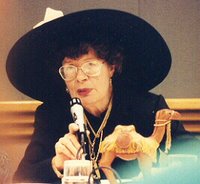 Photo credit: Sue Feder.
Photo credit: Sue Feder.
Dr. Barbara Mertz, better known under her pseudonyms Elizabeth Peters and Barbara Michaels, turns 79 today. Her latest novel featuring intrepid Egyptologist Amelia Peabody Emerson is Tomb of the Golden Bird.
A University of Chicago graduate, Mertz began her fiction career with The Master of Blacktower (1966) as Michaels; the Peters pseudonym debuted in 1968 with The Jackal's Head. Her rollicking Murders of Richard III (1974) riled the Richard III Society so much that it was successful in banning the novel from England for many years. The parasol-wielding Amelia Peabody, partially based on bestselling novelist and Egyptologist Amelia B. Edwards, made her debut in 1975 in Crocodile on the Sandbank.
Mertz's nonfiction books Red Land, Black Land and Temples, Tombs, and Hieroglyphs are staples of undergraduate Egyptology courses; indeed, the galaxy-traveling archaeologist played by James Spader in Stargate packs a copy of Temples, Tombs, and Hieroglyphs in his luggage. She endowed a scholarship program at Hood College (Md.) for fledgling mystery writers and was the prime mover behind the founding of Malice Domestic Ltd.
I met her in 1984, and my life hasn't been the same since (a common phenomenon). For a discussion of her work as Michaels, see my article in summer 1996 issue of The Armchair Detective, "Novels of Many Shadows: The Messages of Barbara Michaels."
 Photo credit: Sue Feder.
Photo credit: Sue Feder.Dr. Barbara Mertz, better known under her pseudonyms Elizabeth Peters and Barbara Michaels, turns 79 today. Her latest novel featuring intrepid Egyptologist Amelia Peabody Emerson is Tomb of the Golden Bird.
A University of Chicago graduate, Mertz began her fiction career with The Master of Blacktower (1966) as Michaels; the Peters pseudonym debuted in 1968 with The Jackal's Head. Her rollicking Murders of Richard III (1974) riled the Richard III Society so much that it was successful in banning the novel from England for many years. The parasol-wielding Amelia Peabody, partially based on bestselling novelist and Egyptologist Amelia B. Edwards, made her debut in 1975 in Crocodile on the Sandbank.
Mertz's nonfiction books Red Land, Black Land and Temples, Tombs, and Hieroglyphs are staples of undergraduate Egyptology courses; indeed, the galaxy-traveling archaeologist played by James Spader in Stargate packs a copy of Temples, Tombs, and Hieroglyphs in his luggage. She endowed a scholarship program at Hood College (Md.) for fledgling mystery writers and was the prime mover behind the founding of Malice Domestic Ltd.
I met her in 1984, and my life hasn't been the same since (a common phenomenon). For a discussion of her work as Michaels, see my article in summer 1996 issue of The Armchair Detective, "Novels of Many Shadows: The Messages of Barbara Michaels."
Monday, September 25, 2006
Happy birthday, William Faulkner.
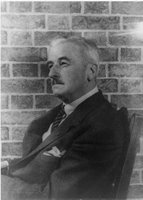 Mississippi's own William Faulkner would have turned 109 today. A devoted mystery fan, Faulkner made several contributions to the genre: the short story "A Rose for Emily," the short story collection Knight's Gambit, the novels Intruder in the Dust and Sanctuary, and the screenplay for Chandler's The Big Sleep.
Mississippi's own William Faulkner would have turned 109 today. A devoted mystery fan, Faulkner made several contributions to the genre: the short story "A Rose for Emily," the short story collection Knight's Gambit, the novels Intruder in the Dust and Sanctuary, and the screenplay for Chandler's The Big Sleep.
 Mississippi's own William Faulkner would have turned 109 today. A devoted mystery fan, Faulkner made several contributions to the genre: the short story "A Rose for Emily," the short story collection Knight's Gambit, the novels Intruder in the Dust and Sanctuary, and the screenplay for Chandler's The Big Sleep.
Mississippi's own William Faulkner would have turned 109 today. A devoted mystery fan, Faulkner made several contributions to the genre: the short story "A Rose for Emily," the short story collection Knight's Gambit, the novels Intruder in the Dust and Sanctuary, and the screenplay for Chandler's The Big Sleep.
Saturday, September 23, 2006
Happy birthday, Baroness Orczy.
 Emma Magdalena Rosalia Maria Josefa Barbara Orczy, aka Baroness Orczy, was born on September 23, 1865. She died in 1947. Best known for that swashbuckling figure The Scarlet Pimpernel, she also made some notable mystery contributions: Stories with Bill Owen, known as "The Old Man in the Corner," often considered the first appearance of the modern armchair detective; and Lady Molly of Scotland Yard (1910), in which Lady Molly and her maid Mary Granard join Scotland Yard's "Female Department," as Lady Molly seeks to exonerate her wrongly accused husband. As Granard comments, "[M]y firm belief is that we shouldn't have half so many undetected crimes if some of the so-called mysteries were put to the test of feminine investigation."
Emma Magdalena Rosalia Maria Josefa Barbara Orczy, aka Baroness Orczy, was born on September 23, 1865. She died in 1947. Best known for that swashbuckling figure The Scarlet Pimpernel, she also made some notable mystery contributions: Stories with Bill Owen, known as "The Old Man in the Corner," often considered the first appearance of the modern armchair detective; and Lady Molly of Scotland Yard (1910), in which Lady Molly and her maid Mary Granard join Scotland Yard's "Female Department," as Lady Molly seeks to exonerate her wrongly accused husband. As Granard comments, "[M]y firm belief is that we shouldn't have half so many undetected crimes if some of the so-called mysteries were put to the test of feminine investigation."
 Emma Magdalena Rosalia Maria Josefa Barbara Orczy, aka Baroness Orczy, was born on September 23, 1865. She died in 1947. Best known for that swashbuckling figure The Scarlet Pimpernel, she also made some notable mystery contributions: Stories with Bill Owen, known as "The Old Man in the Corner," often considered the first appearance of the modern armchair detective; and Lady Molly of Scotland Yard (1910), in which Lady Molly and her maid Mary Granard join Scotland Yard's "Female Department," as Lady Molly seeks to exonerate her wrongly accused husband. As Granard comments, "[M]y firm belief is that we shouldn't have half so many undetected crimes if some of the so-called mysteries were put to the test of feminine investigation."
Emma Magdalena Rosalia Maria Josefa Barbara Orczy, aka Baroness Orczy, was born on September 23, 1865. She died in 1947. Best known for that swashbuckling figure The Scarlet Pimpernel, she also made some notable mystery contributions: Stories with Bill Owen, known as "The Old Man in the Corner," often considered the first appearance of the modern armchair detective; and Lady Molly of Scotland Yard (1910), in which Lady Molly and her maid Mary Granard join Scotland Yard's "Female Department," as Lady Molly seeks to exonerate her wrongly accused husband. As Granard comments, "[M]y firm belief is that we shouldn't have half so many undetected crimes if some of the so-called mysteries were put to the test of feminine investigation."
Sunday, September 17, 2006
Happy dual birthday, Robert B. Parker/John Creasey.
 Author Robert Brown Parker, creator of Spenser, Jesse Stone, and Sunny Randall, turns 74 today. You can hear Parker in my June interview with him here, or check out The Robert B. Parker Companion, coauthored by myself and Dean James.
Author Robert Brown Parker, creator of Spenser, Jesse Stone, and Sunny Randall, turns 74 today. You can hear Parker in my June interview with him here, or check out The Robert B. Parker Companion, coauthored by myself and Dean James.
British mystery phenomenon John Creasey, who is credited with publishing more than 560 novels (yes, you read that right: 560), was born on this day in 1908. He died in 1973. His many memorable characters include Sexton Blake, the Hon. Richard Rollison (aka "The Toff," who bears some similarities to Leslie Charteris's "The Saint"), Roger West of Scotland Yard, Superintendent Folly, spy Gordon Craigie, and reformed thief John Mannering. The film Gideon's Day (1958), starring Jack Hawkins and directed by John Ford, is an adaptation of Creasey's novel of the same name (aka Gideon of Scotland Yard).
 Author Robert Brown Parker, creator of Spenser, Jesse Stone, and Sunny Randall, turns 74 today. You can hear Parker in my June interview with him here, or check out The Robert B. Parker Companion, coauthored by myself and Dean James.
Author Robert Brown Parker, creator of Spenser, Jesse Stone, and Sunny Randall, turns 74 today. You can hear Parker in my June interview with him here, or check out The Robert B. Parker Companion, coauthored by myself and Dean James.British mystery phenomenon John Creasey, who is credited with publishing more than 560 novels (yes, you read that right: 560), was born on this day in 1908. He died in 1973. His many memorable characters include Sexton Blake, the Hon. Richard Rollison (aka "The Toff," who bears some similarities to Leslie Charteris's "The Saint"), Roger West of Scotland Yard, Superintendent Folly, spy Gordon Craigie, and reformed thief John Mannering. The film Gideon's Day (1958), starring Jack Hawkins and directed by John Ford, is an adaptation of Creasey's novel of the same name (aka Gideon of Scotland Yard).
Friday, September 15, 2006
Happy dual birthday, Loren Estleman/Agatha Christie
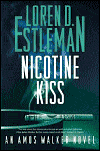 Versatile mystery/western author Loren Estleman, creator of sleuth Amos Walker, turns 54 today, while Agatha Christie would have turned 116.
Versatile mystery/western author Loren Estleman, creator of sleuth Amos Walker, turns 54 today, while Agatha Christie would have turned 116.
Estleman's latest novels are Nicotine Kiss (Walker series) and The Adventures of Johnny Vermillion (western featuring an actor-cum-bank robber). Christie's is Miss Marple's Final Cases. You can listen to various Christie works on BBC Radio 7 this month; go here for details.
 Versatile mystery/western author Loren Estleman, creator of sleuth Amos Walker, turns 54 today, while Agatha Christie would have turned 116.
Versatile mystery/western author Loren Estleman, creator of sleuth Amos Walker, turns 54 today, while Agatha Christie would have turned 116.Estleman's latest novels are Nicotine Kiss (Walker series) and The Adventures of Johnny Vermillion (western featuring an actor-cum-bank robber). Christie's is Miss Marple's Final Cases. You can listen to various Christie works on BBC Radio 7 this month; go here for details.
Thursday, September 14, 2006
Happy birthday, Carroll John Daly.
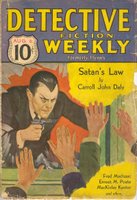 Born on September 14, 1889, pulp writer Carroll John Daly is credited with creating the first hard-boiled detective in "The False Burton Combs" (Black Mask, 1922; rpt. The Hard-Boiled Detective: Stories from Black Mask Magazine 1920-1951, ed. Herbert Ruhm, Vintage, 1977). He died in 1958. Daly's notable characters include the interestingly named Satan Hall and tough investigator Race Williams.
Born on September 14, 1889, pulp writer Carroll John Daly is credited with creating the first hard-boiled detective in "The False Burton Combs" (Black Mask, 1922; rpt. The Hard-Boiled Detective: Stories from Black Mask Magazine 1920-1951, ed. Herbert Ruhm, Vintage, 1977). He died in 1958. Daly's notable characters include the interestingly named Satan Hall and tough investigator Race Williams.
A possible article of interest is Penguin publicist Michael S. Barson's "'There's No Sex in Crime': The Two-Fisted Homilies of Race Williams" (CLUES: A Journal of Detection 2.2 [F/W 1981]: 103-12). You can probably only find it via interlibrary loan.
 Born on September 14, 1889, pulp writer Carroll John Daly is credited with creating the first hard-boiled detective in "The False Burton Combs" (Black Mask, 1922; rpt. The Hard-Boiled Detective: Stories from Black Mask Magazine 1920-1951, ed. Herbert Ruhm, Vintage, 1977). He died in 1958. Daly's notable characters include the interestingly named Satan Hall and tough investigator Race Williams.
Born on September 14, 1889, pulp writer Carroll John Daly is credited with creating the first hard-boiled detective in "The False Burton Combs" (Black Mask, 1922; rpt. The Hard-Boiled Detective: Stories from Black Mask Magazine 1920-1951, ed. Herbert Ruhm, Vintage, 1977). He died in 1958. Daly's notable characters include the interestingly named Satan Hall and tough investigator Race Williams.A possible article of interest is Penguin publicist Michael S. Barson's "'There's No Sex in Crime': The Two-Fisted Homilies of Race Williams" (CLUES: A Journal of Detection 2.2 [F/W 1981]: 103-12). You can probably only find it via interlibrary loan.
Tuesday, September 12, 2006
Who Knows What Evil Lurks...
 Magician and writer Walter B. Gibson was born on September 12, 1897, and died in 1985. The author of more than 300 novels, he is best known for one immortal creation: The Shadow, the crimefighter who has the ability "to cloud men's minds."
Magician and writer Walter B. Gibson was born on September 12, 1897, and died in 1985. The author of more than 300 novels, he is best known for one immortal creation: The Shadow, the crimefighter who has the ability "to cloud men's minds."
The Shadow spawned a magazine, a comic book, a long-running radio series (which featured Orson Welles for a year as Lamont Cranston/The Shadow), and a 1994 film starring Alec Baldwin, Penelope Ann Miller, and Ian McKellen that, I confess, I hugely enjoyed.
For more on Gibson, see Walter B. Gibson and the Shadow by Thomas J. Shimeld (McFarland, 2005).
 Magician and writer Walter B. Gibson was born on September 12, 1897, and died in 1985. The author of more than 300 novels, he is best known for one immortal creation: The Shadow, the crimefighter who has the ability "to cloud men's minds."
Magician and writer Walter B. Gibson was born on September 12, 1897, and died in 1985. The author of more than 300 novels, he is best known for one immortal creation: The Shadow, the crimefighter who has the ability "to cloud men's minds."The Shadow spawned a magazine, a comic book, a long-running radio series (which featured Orson Welles for a year as Lamont Cranston/The Shadow), and a 1994 film starring Alec Baldwin, Penelope Ann Miller, and Ian McKellen that, I confess, I hugely enjoyed.
For more on Gibson, see Walter B. Gibson and the Shadow by Thomas J. Shimeld (McFarland, 2005).
Sunday, September 10, 2006
Happy birthday, Peter Lovesey.
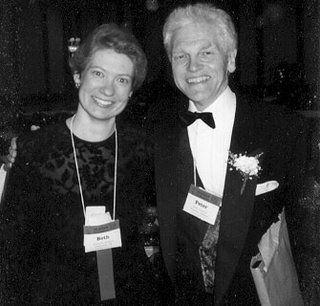 Peter Lovesey and I display our sartorial finery at Malice Domestic VIII in 1996.
Peter Lovesey and I display our sartorial finery at Malice Domestic VIII in 1996.
Diamond Dagger recipient Peter Lovesey, author of numerous mysteries such as the Victorian Sergeant Cribb series, police procedurals with detective Peter Diamond, and the hilarious Bertie, Prince of Wales series, turns 70 today.
There's a Lovesey work to suit every reading taste. I personally prefer his historicals, where he balances meticulous fact with a swiftly moving plot and memorable characters, such as his masterful The False Inspector Dew (murder with Crippen overtones in 1921 on the Mauritania, which was captained by Arthur Rostron, rescuer of Titanic survivors as captain of the Carpathia). Lovesey's delicious sense of humor is showcased in works such as "The Crime of Miss Oyster Brown" and On the Edge, which was adapted as the PBS production Dead Gorgeous (bored rich woman in postwar London proposes to her friend that they kill each other's husbands). Another one not to be missed is the audio version of "The Corbett Correspondence," coauthored with Edward Marston, in which Patrick Macnee and Juliet Mills play amorous spies in an epistolary tale that features a mysterious manuscript, sinister servants named Deeck and Garbo, and various other hysterical details ("behind the erotic tapestry..."). It appears in Malice Domestic 6, which won an Audie Award in the Best Short Stories/Essays/Collections category.
Many of Lovesey's books are published by Soho Press, including The Circle (about an eccentric writers' group and a publisher who gets bumped off). To listen to my interview with Lovesey from my radio show "It's a Mystery," go here.
 Peter Lovesey and I display our sartorial finery at Malice Domestic VIII in 1996.
Peter Lovesey and I display our sartorial finery at Malice Domestic VIII in 1996.Diamond Dagger recipient Peter Lovesey, author of numerous mysteries such as the Victorian Sergeant Cribb series, police procedurals with detective Peter Diamond, and the hilarious Bertie, Prince of Wales series, turns 70 today.
There's a Lovesey work to suit every reading taste. I personally prefer his historicals, where he balances meticulous fact with a swiftly moving plot and memorable characters, such as his masterful The False Inspector Dew (murder with Crippen overtones in 1921 on the Mauritania, which was captained by Arthur Rostron, rescuer of Titanic survivors as captain of the Carpathia). Lovesey's delicious sense of humor is showcased in works such as "The Crime of Miss Oyster Brown" and On the Edge, which was adapted as the PBS production Dead Gorgeous (bored rich woman in postwar London proposes to her friend that they kill each other's husbands). Another one not to be missed is the audio version of "The Corbett Correspondence," coauthored with Edward Marston, in which Patrick Macnee and Juliet Mills play amorous spies in an epistolary tale that features a mysterious manuscript, sinister servants named Deeck and Garbo, and various other hysterical details ("behind the erotic tapestry..."). It appears in Malice Domestic 6, which won an Audie Award in the Best Short Stories/Essays/Collections category.
Many of Lovesey's books are published by Soho Press, including The Circle (about an eccentric writers' group and a publisher who gets bumped off). To listen to my interview with Lovesey from my radio show "It's a Mystery," go here.
Saturday, September 09, 2006
Happy birthday, Phyllis Whitney.
 Photo (from left): Elizabeth Peters, Anne Perry, and Phyllis Whitney at Malice Domestic V in 1993. Photo by Laura Hyzy.
Photo (from left): Elizabeth Peters, Anne Perry, and Phyllis Whitney at Malice Domestic V in 1993. Photo by Laura Hyzy.
The legendary Phyllis Whitney, author of more than 75 books and a two-time Edgar winner and Grand Master, turns 103 years old today. Her numerous credits include romantic suspense, children's/young adult novels, and books on writing. She published her first book in 1943 (Red Is for Murder).
I worked with her on Malice Domestic 5, which she introduced. Tremendously supportive to other mystery writers throughout her long career, she is a warm and gracious lady. Count me among the many waiting eagerly for her autobiography, which is in progress in longhand.
 Photo (from left): Elizabeth Peters, Anne Perry, and Phyllis Whitney at Malice Domestic V in 1993. Photo by Laura Hyzy.
Photo (from left): Elizabeth Peters, Anne Perry, and Phyllis Whitney at Malice Domestic V in 1993. Photo by Laura Hyzy.The legendary Phyllis Whitney, author of more than 75 books and a two-time Edgar winner and Grand Master, turns 103 years old today. Her numerous credits include romantic suspense, children's/young adult novels, and books on writing. She published her first book in 1943 (Red Is for Murder).
I worked with her on Malice Domestic 5, which she introduced. Tremendously supportive to other mystery writers throughout her long career, she is a warm and gracious lady. Count me among the many waiting eagerly for her autobiography, which is in progress in longhand.
Sunday, September 03, 2006
A. J. Cronin.
 In the car amid the dregs of Hurricane Ernesto, I listened to the delightful BBC audio adaptation Dr. Finlay: Adventures of a Black Bag by Scottish physician-turned-author A. J. Cronin, probably best known for his bestselling novels The Citadel and The Keys of the Kingdom.
In the car amid the dregs of Hurricane Ernesto, I listened to the delightful BBC audio adaptation Dr. Finlay: Adventures of a Black Bag by Scottish physician-turned-author A. J. Cronin, probably best known for his bestselling novels The Citadel and The Keys of the Kingdom.
You may remember the 1944 film of The Keys of the Kingdom with Gregory Peck, the Doctor Finlay series on PBS starring David Rintoul and Ian Bannen (1993), and The Citadel film versions with Robert Donat (1938) and Ben Cross (1983). This BBC Radio 4 adaptation features stories narrated by Dr. Cameron, the elder partner in a medical practice located in the Scottish Highlands, about his stubborn younger colleague Dr. Finlay. The stories have the distinct feeling of James Herriot's All Creatures Great and Small via eccentric townspeople; a young, dedicated protagonist who has a lot to learn; and poignant tales such as one in which a devoted wife keeps a serious secret from her soccer-star husband so as not to distract him from the championship match.
There's also a follow-up available, Dr. Finlay: Further Adventures of a Black Bag.
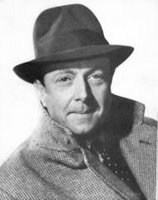 Cronin (1896-1981), a surgeon in the Royal Navy during World War I, turned to writing when an ulcer forced him to give up his medical practice. There's a fun article by the late John Z. Bowers in the University of Maryland's medical alumni magazine about Cronin and other "truants from medicine."
Cronin (1896-1981), a surgeon in the Royal Navy during World War I, turned to writing when an ulcer forced him to give up his medical practice. There's a fun article by the late John Z. Bowers in the University of Maryland's medical alumni magazine about Cronin and other "truants from medicine."
 In the car amid the dregs of Hurricane Ernesto, I listened to the delightful BBC audio adaptation Dr. Finlay: Adventures of a Black Bag by Scottish physician-turned-author A. J. Cronin, probably best known for his bestselling novels The Citadel and The Keys of the Kingdom.
In the car amid the dregs of Hurricane Ernesto, I listened to the delightful BBC audio adaptation Dr. Finlay: Adventures of a Black Bag by Scottish physician-turned-author A. J. Cronin, probably best known for his bestselling novels The Citadel and The Keys of the Kingdom.You may remember the 1944 film of The Keys of the Kingdom with Gregory Peck, the Doctor Finlay series on PBS starring David Rintoul and Ian Bannen (1993), and The Citadel film versions with Robert Donat (1938) and Ben Cross (1983). This BBC Radio 4 adaptation features stories narrated by Dr. Cameron, the elder partner in a medical practice located in the Scottish Highlands, about his stubborn younger colleague Dr. Finlay. The stories have the distinct feeling of James Herriot's All Creatures Great and Small via eccentric townspeople; a young, dedicated protagonist who has a lot to learn; and poignant tales such as one in which a devoted wife keeps a serious secret from her soccer-star husband so as not to distract him from the championship match.
There's also a follow-up available, Dr. Finlay: Further Adventures of a Black Bag.
 Cronin (1896-1981), a surgeon in the Royal Navy during World War I, turned to writing when an ulcer forced him to give up his medical practice. There's a fun article by the late John Z. Bowers in the University of Maryland's medical alumni magazine about Cronin and other "truants from medicine."
Cronin (1896-1981), a surgeon in the Royal Navy during World War I, turned to writing when an ulcer forced him to give up his medical practice. There's a fun article by the late John Z. Bowers in the University of Maryland's medical alumni magazine about Cronin and other "truants from medicine."
Friday, September 01, 2006
Happy birthday, Victoria Holt
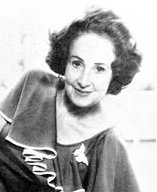 Eleanor Hibbert, aka Victoria Holt, Jean Plaidy, Philippa Carr, and four other pseudonyms, was born on September 1, 1906. She died in 1993.
Eleanor Hibbert, aka Victoria Holt, Jean Plaidy, Philippa Carr, and four other pseudonyms, was born on September 1, 1906. She died in 1993.
A major figure in romantic suspense, she wrote nearly 200 works. Mystery fans may be most interested in her novels under the pseudonym Elbur Ford: Poison in Pimlico, Flesh and the Devil, The Bed Disturbed, and, most notably, Such Bitter Business (US title: Evil in the House), which is based on the Constance Kent case of 1860 (Kent was convicted of killing her half brother).
 Eleanor Hibbert, aka Victoria Holt, Jean Plaidy, Philippa Carr, and four other pseudonyms, was born on September 1, 1906. She died in 1993.
Eleanor Hibbert, aka Victoria Holt, Jean Plaidy, Philippa Carr, and four other pseudonyms, was born on September 1, 1906. She died in 1993.A major figure in romantic suspense, she wrote nearly 200 works. Mystery fans may be most interested in her novels under the pseudonym Elbur Ford: Poison in Pimlico, Flesh and the Devil, The Bed Disturbed, and, most notably, Such Bitter Business (US title: Evil in the House), which is based on the Constance Kent case of 1860 (Kent was convicted of killing her half brother).
Sunday, August 27, 2006
Happy birthday, Lady Antonia Fraser
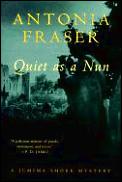 Lady Antonia Fraser turns 74 today. Well-known for her historical works such as Faith and Treason: The Story of the Gunpowder Plot, The Warrior Queens, and The Weaker Vessel, she also is an accomplished mystery writer with her series featuring journalist Jemima Shore, which began in 1977 with Quiet as a Nun and was adapted into the TV series Jemima Shore Investigates. Fraser has an amazing literary family: her mother is biographer Elizabeth Longford; her brother, nonfiction writer Thomas Pakenham; her sister, novelist Rachel Billington; and yes, she's married to playwright Harold Pinter.
Lady Antonia Fraser turns 74 today. Well-known for her historical works such as Faith and Treason: The Story of the Gunpowder Plot, The Warrior Queens, and The Weaker Vessel, she also is an accomplished mystery writer with her series featuring journalist Jemima Shore, which began in 1977 with Quiet as a Nun and was adapted into the TV series Jemima Shore Investigates. Fraser has an amazing literary family: her mother is biographer Elizabeth Longford; her brother, nonfiction writer Thomas Pakenham; her sister, novelist Rachel Billington; and yes, she's married to playwright Harold Pinter.
 Lady Antonia Fraser turns 74 today. Well-known for her historical works such as Faith and Treason: The Story of the Gunpowder Plot, The Warrior Queens, and The Weaker Vessel, she also is an accomplished mystery writer with her series featuring journalist Jemima Shore, which began in 1977 with Quiet as a Nun and was adapted into the TV series Jemima Shore Investigates. Fraser has an amazing literary family: her mother is biographer Elizabeth Longford; her brother, nonfiction writer Thomas Pakenham; her sister, novelist Rachel Billington; and yes, she's married to playwright Harold Pinter.
Lady Antonia Fraser turns 74 today. Well-known for her historical works such as Faith and Treason: The Story of the Gunpowder Plot, The Warrior Queens, and The Weaker Vessel, she also is an accomplished mystery writer with her series featuring journalist Jemima Shore, which began in 1977 with Quiet as a Nun and was adapted into the TV series Jemima Shore Investigates. Fraser has an amazing literary family: her mother is biographer Elizabeth Longford; her brother, nonfiction writer Thomas Pakenham; her sister, novelist Rachel Billington; and yes, she's married to playwright Harold Pinter.
Friday, August 25, 2006
Happy birthday, John Buchan
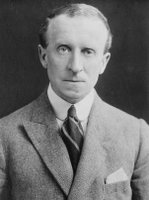 Baron Tweedsmuir, better known as Scottish thriller writer extraordinaire John Buchan, was born on August 26, 1875. He died in 1940 as Governor-General of Canada.
Baron Tweedsmuir, better known as Scottish thriller writer extraordinaire John Buchan, was born on August 26, 1875. He died in 1940 as Governor-General of Canada.
Buchan worked for British intelligence during WWI; served as a member of Parliament; and wrote historical fiction, criticism, poetry, history, and biography. But it is probably for his novel The Thirty-Nine Steps (1915), in which mining engineer Richard Hannay becomes embroiled in espionage, that he is best known because of the Alfred Hitchcock film of 1935 starring Robert Donat and Madeleine Carroll (don't we all remember the chill we felt when Mr. Bad Guy holds up his hand, and we see along with Hannay that he is missing part of a finger).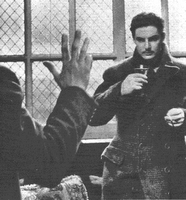
The Thirty-Nine Steps was filmed two additional times, in 1959 starring Kenneth More, and in 1978 with Robert Powell, Karen Dotrice, and David Warner in one of his delicious villainous turns. Powell went on to star in a short-lived Thames television series "Hannay" (1988-89), but the scripts were not based on the other Hannay stories such as Greenmantle (1916), Mr. Standfast (1919), and The Three Hostages (1924). It was rumored that after Hitchcock directed Family Plot that he was considering filming Greenmantle, which I regard as an attempt to return to his roots, but he died before these plans could come to fruition.
Buchan dubbed his thrillers "shockers," which he called "the romance where the incidents defy the probabilities, and march just inside the borders of the possible." He also wrote several novels with lawyer Edward Leithen, such as The Power-House (1913), The Dancing Floor (1926), and Sick Heart River (1941). For more information on Buchan, read Buchan's memoir, Memory Hold-the-Door; John Buchan: The Presbyterian Cavalier by Andrew Lownie; or visit the John Buchan Society Web site, which also has a complete bibliography of his work.
 Baron Tweedsmuir, better known as Scottish thriller writer extraordinaire John Buchan, was born on August 26, 1875. He died in 1940 as Governor-General of Canada.
Baron Tweedsmuir, better known as Scottish thriller writer extraordinaire John Buchan, was born on August 26, 1875. He died in 1940 as Governor-General of Canada.Buchan worked for British intelligence during WWI; served as a member of Parliament; and wrote historical fiction, criticism, poetry, history, and biography. But it is probably for his novel The Thirty-Nine Steps (1915), in which mining engineer Richard Hannay becomes embroiled in espionage, that he is best known because of the Alfred Hitchcock film of 1935 starring Robert Donat and Madeleine Carroll (don't we all remember the chill we felt when Mr. Bad Guy holds up his hand, and we see along with Hannay that he is missing part of a finger).

The Thirty-Nine Steps was filmed two additional times, in 1959 starring Kenneth More, and in 1978 with Robert Powell, Karen Dotrice, and David Warner in one of his delicious villainous turns. Powell went on to star in a short-lived Thames television series "Hannay" (1988-89), but the scripts were not based on the other Hannay stories such as Greenmantle (1916), Mr. Standfast (1919), and The Three Hostages (1924). It was rumored that after Hitchcock directed Family Plot that he was considering filming Greenmantle, which I regard as an attempt to return to his roots, but he died before these plans could come to fruition.
Buchan dubbed his thrillers "shockers," which he called "the romance where the incidents defy the probabilities, and march just inside the borders of the possible." He also wrote several novels with lawyer Edward Leithen, such as The Power-House (1913), The Dancing Floor (1926), and Sick Heart River (1941). For more information on Buchan, read Buchan's memoir, Memory Hold-the-Door; John Buchan: The Presbyterian Cavalier by Andrew Lownie; or visit the John Buchan Society Web site, which also has a complete bibliography of his work.
Monday, August 21, 2006
Happy birthday, Anthony Boucher
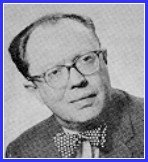 The industrious critic/editor/sci-fi author/mystery writer Anthony Boucher, aka William Anthony Parker White, who gave his name to mystery convention Bouchercon, was born on August 21, 1911. He died in 1968. He received the Edgar Award for mystery criticism in 1946, 1950, and 1953 (go here for volumes of his collected reviews).
The industrious critic/editor/sci-fi author/mystery writer Anthony Boucher, aka William Anthony Parker White, who gave his name to mystery convention Bouchercon, was born on August 21, 1911. He died in 1968. He received the Edgar Award for mystery criticism in 1946, 1950, and 1953 (go here for volumes of his collected reviews).
His intriguing Rocket to the Morgue, written under the pseudonym of 19th-century murderer H. H. Holmes, features thinly disguised versions of his sci-fi colleagues Hugo Gernsback, Robert Heinlein, and L. Ron Hubbard. His mysteries include locked-room murders The Case of the Solid Key and Nine Times Nine, and puzzle story The Case of the Seven of Calgary. He also wrote scripts for radio series such as Sherlock Holmes and The Casebook of Gregory Hood.
 The industrious critic/editor/sci-fi author/mystery writer Anthony Boucher, aka William Anthony Parker White, who gave his name to mystery convention Bouchercon, was born on August 21, 1911. He died in 1968. He received the Edgar Award for mystery criticism in 1946, 1950, and 1953 (go here for volumes of his collected reviews).
The industrious critic/editor/sci-fi author/mystery writer Anthony Boucher, aka William Anthony Parker White, who gave his name to mystery convention Bouchercon, was born on August 21, 1911. He died in 1968. He received the Edgar Award for mystery criticism in 1946, 1950, and 1953 (go here for volumes of his collected reviews).His intriguing Rocket to the Morgue, written under the pseudonym of 19th-century murderer H. H. Holmes, features thinly disguised versions of his sci-fi colleagues Hugo Gernsback, Robert Heinlein, and L. Ron Hubbard. His mysteries include locked-room murders The Case of the Solid Key and Nine Times Nine, and puzzle story The Case of the Seven of Calgary. He also wrote scripts for radio series such as Sherlock Holmes and The Casebook of Gregory Hood.
Sunday, August 20, 2006
Happy birthday, H. P. Lovecraft
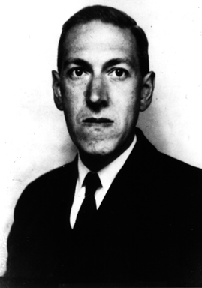 Master of weird fiction H. P. Lovecraft was born on this day in 1890. He died in 1937.
Master of weird fiction H. P. Lovecraft was born on this day in 1890. He died in 1937.
His stories include the Poe-inspired "The Rats in the Walls," "The Dunwich Horror," "The Whisperer in Darkness," and The Case of Charles Dexter Ward. His work inspired authors such as Robert Bloch, Robert E. Howard (creator of Conan the Barbarian), and August Derleth. Several collections of his tales are published by Arkham House. For further details, go here.
 Master of weird fiction H. P. Lovecraft was born on this day in 1890. He died in 1937.
Master of weird fiction H. P. Lovecraft was born on this day in 1890. He died in 1937.His stories include the Poe-inspired "The Rats in the Walls," "The Dunwich Horror," "The Whisperer in Darkness," and The Case of Charles Dexter Ward. His work inspired authors such as Robert Bloch, Robert E. Howard (creator of Conan the Barbarian), and August Derleth. Several collections of his tales are published by Arkham House. For further details, go here.
Tuesday, August 15, 2006
Happy birthday, Georgette Heyer.
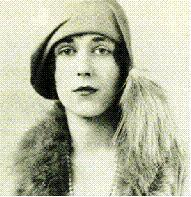 Georgette Heyer, beloved for her lively and meticulously researched Regency romances but also a fine mystery writer, was born on August 16, 1902. She died in 1974.
Georgette Heyer, beloved for her lively and meticulously researched Regency romances but also a fine mystery writer, was born on August 16, 1902. She died in 1974.
Heyer actually wrote her mysteries in conjunction with her husband, George Ronald Rougier. A particular favorite of mine is Behold, Here's Poison, with the son and heir who specializes in insulting all his relations, the born-again lady who insists on "testifying" at dinner, and a pseudo-prince who is constantly confused with the family dog (also named Prince). A friend of mine singles out Envious Casca as his favorite, dubbing it "the house party from hell."
A common affliction among Heyerites is reading and rereading her paperbacks until they fall apart, and then one must purchase new copies. My favorites among her Regencies include Cotillion (where Heyer accomplishes a rather neat switch on who we imagine the love interest to be), The Toll Gate (restless ex-soldier finds skullduggery and love in the countryside), and Frederica (bored marquis finds more than he bargained for in a pack of distant relatives).
For more on Heyer, you can read The Private World of Georgette Heyer by fellow novelist Jane Aiken Hodge, and Georgette Heyer: A Critical Retrospective has all sorts of intriguing material, including articles and short stories by Heyer. Go here to learn more about the Yahoogroup that discusses Heyer's work. Malice Domestic Ltd. has selected Heyer as its 2007 Ghost of Honor.
 Georgette Heyer, beloved for her lively and meticulously researched Regency romances but also a fine mystery writer, was born on August 16, 1902. She died in 1974.
Georgette Heyer, beloved for her lively and meticulously researched Regency romances but also a fine mystery writer, was born on August 16, 1902. She died in 1974.Heyer actually wrote her mysteries in conjunction with her husband, George Ronald Rougier. A particular favorite of mine is Behold, Here's Poison, with the son and heir who specializes in insulting all his relations, the born-again lady who insists on "testifying" at dinner, and a pseudo-prince who is constantly confused with the family dog (also named Prince). A friend of mine singles out Envious Casca as his favorite, dubbing it "the house party from hell."
A common affliction among Heyerites is reading and rereading her paperbacks until they fall apart, and then one must purchase new copies. My favorites among her Regencies include Cotillion (where Heyer accomplishes a rather neat switch on who we imagine the love interest to be), The Toll Gate (restless ex-soldier finds skullduggery and love in the countryside), and Frederica (bored marquis finds more than he bargained for in a pack of distant relatives).
For more on Heyer, you can read The Private World of Georgette Heyer by fellow novelist Jane Aiken Hodge, and Georgette Heyer: A Critical Retrospective has all sorts of intriguing material, including articles and short stories by Heyer. Go here to learn more about the Yahoogroup that discusses Heyer's work. Malice Domestic Ltd. has selected Heyer as its 2007 Ghost of Honor.
Saturday, August 12, 2006
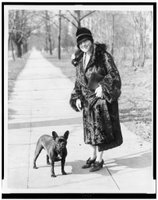 Happy birthday, Mary Roberts Rinehart.
Happy birthday, Mary Roberts Rinehart.Mary Roberts Rinehart, whose hugely successful mystery career spanned a half-century, would have been 130 today. She is buried in Arlington Cemetery. Undeservedly disparaged for creating the "Had-I-But-Known" approach to mystery writing, she was a writer of great gifts, and her play The Bat grossed over $9 million in the 1920s. I especially recommend The Man in Lower Ten (1909), with its Hitchcockian plot of a bored, staid lawyer who becomes immeshed in murder on a train and a particularly hilarious take on the amateur sleuth. Also take a look at MRR's nonfiction Kings, Queens, and Pawns (1915), her clear-eyed account of visiting the wounded in Belgian and French hospitals during WWI (MRR trained as a nurse) and interviewing the King and Queen of Belgium.
Photo: MRR out with her French bulldog, taken somewhere between 1920 and 1932.
Thursday, August 10, 2006
 Stan Freberg.
Stan Freberg. Over on Bill Crider's blog, there was a tribute to comedian Stan Freberg on the occasion of his 80th birthday this week. I've played some Freberg on my radio show "It's a Mystery," such as "Sam Splayed, Detective." On the "It's a Mystery" Web site, I've posted a clip from his 1957 radio show: the classic "St. George and the Dragonet." Go here to listen.
Friday, July 21, 2006
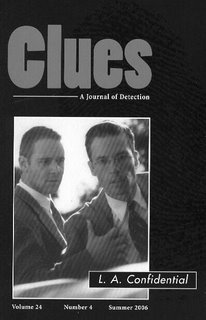 CLUES Summer 06 issue published
CLUES Summer 06 issue publishedThe summer 06 issue of CLUES: A Journal of Detection has been published, featuring articles on James Ellroy's LA Quartet, Raymond Chandler's portrayal of psychiatrists in his work, Lady Macbeth in detective fiction, the Nell Bray novels by Gillian Linscott, and Reginald Hill's Good Morning, Midnight. For further details, go here.
Tuesday, July 11, 2006
 Martha Gellhorn.
Martha Gellhorn.I love biographies, especially literary ones, and Caroline Moorehead's Gellhorn: A Twentieth-Century Life is a fascinating one. Gellhorn's considerable literary gifts were often overshadowed by her five-year marriage to Hemingway.
Best known for her reporting on the Spanish Civil War, she was profoundly and permanently affected by seeing Dachau during her reporting on WWII. The section on her reporting on the Vietnam War is particularly interesting. The most fun bit deals with Gellhorn's participation in the Mary McCarthy-Lillian Hellman row in 1980 (Gellhorn had traveled on the same ship as Hellman en route to the Spanish Civil War and disliked her). For a piece for The Paris Review (edited by George Plimpton), Gellhorn coined a new word, apocryphiar, or one who fabricates a story with himself or herself as hero, and discounted Hellman's account (in Pentimento) of life in Madrid at the time, calling Hellman's words "whoppers." She said in a letter to a friend, "[Hellman had] used the Spanish war as a garment to drape herself in."
Moorehead also has edited a volume of Gellhorn's letters; more information on that here.
Sunday, July 02, 2006
 Frank Langella.
Frank Langella.How many remember him as Sherlock Holmes (at left; photo by Jan A. Wein) in the Williamstown Theater Festival of 1977?
Yes, I'm a fan, a result of growing up with a relative of Langella and being fortunate enough to meet him on a few occasions. Perhaps you have your own favorite performance: Langella as the uber-evil chief of staff in Dave? As the title role in Dracula? As William S. Paley in Good Night, and Good Luck? As the roguish sidekick of Ron Moody in Mel Brooks's The Twelve Chairs? In any of his Tony-winning performances (he's won two and been nominated four times)?
As a villain, he can't be beat, but I'm most fond of his turn in the Noel Coward part in "Design for Living," which co-starred the late Raul Julia and Jill Clayburgh, at Circle in the Square in New York. In it, he displayed exemplary comic timing.
Saturday, July 01, 2006
 The Cat Who Went to Paris.
The Cat Who Went to Paris. Audiobooks have kept me sane when navigating Washington, DC-area traffic (as many people seem to get behind the wheel after having frontal lobotomies). A surprise treasure was Peter Gethers's The Cat Who Went to Paris. Former publisher Gethers relates his journey as a confirmed cat hater to cat lover when he adopts Norton, a Scottish fold feline (a breed where the ears are folded down on the cat's head); takes Norton wherever he goes, including restaurants; and watches the intelligent Norton captivate the world. One of the many amusing tales is Gethers's comparison of Spain and France. The Spanish border guards were insistent that Norton needed papers to enter the country (this was a simple day trip). On Gethers's reentry into France, the French guards only had this to say: "Bonjour, Monsieur le Chat. Ca va?" ("Hello, Mr. Cat. How's it going?"). The Cat Who Went to Paris is no cutesy cat book but a captivating memoir in the tradition of Peter Mayle's Toujours Provence.
Friday, June 30, 2006
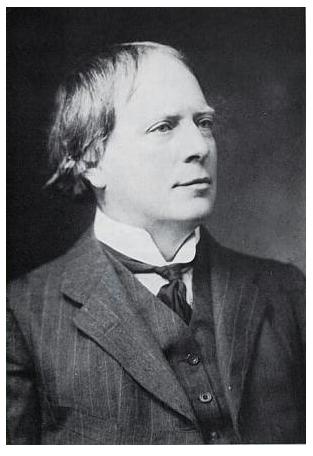 In Praise of Purple Prose
In Praise of Purple ProseOkay, I confess. I really love those 19th- and early 20th-century thrillers with their often overwrought prose. I'm a fan of Louisa May Alcott's work in this area, including A Long, Fatal Love Chase, in which the heroine disguises herself as a man, the man who falls in love with her is a priest, and Alcott, presciently, deals with stalking. Perhaps it's genetic; my sister confesses to an undying devotion for that epitome of villains, Sax Rohmer's Dr. Fu Manchu (insert hissing sounds here).
So imagine my delight when reading an upcoming article for the fall 06 issue of CLUES: A Journal of Detection on the mysteries of Arthur Machen (1863-1947), an inspiration for H.P. Lovecraft and a member of Oscar Wilde's set. Machen's villains are so evil that they dissolve into protoplasm; to wit, in "The White Powder":
"Upon the floor was a dark and putrid mass, seething with corruption and hideous rottenness, neither liquid nor solid, but melting and changing before our eyes, and bubbling with unctuous oily bubbles like boiling pitch. And out of the midst of it I saw two burning points like eyes. "
Now, how can anyone possibly resist that?
You can learn more about Machen at the Friends of Arthur Machen Web site. For etexts of his work, go here.
Monday, June 12, 2006
 Happy Birthday, Dorothy L. Sayers
Happy Birthday, Dorothy L. SayersDorothy L. Sayers was born on June 13, 1893. She could speak Latin, French, and German by the time she was sixteen; she broke new ground when she wrote a play about Jesus, "The Man Who Would Be King," for BBC broadcast (produced by Val Gielgud, John's brother); she was the translator on an acclaimed version of Dante's Divine Comedy. Oh, yeah, and she created aristocratic sleuth Lord Peter Wimsey.
Wimsey appearances on DVD with Ian Carmichael ("The Unpleasantness at the Bellona Club"; "The Nine Tailors"; "Murder Must Advertise"; "Five Red Herrings," "Clouds of Witness") and Edward Petherbridge ("Strong Poison," "Have His Carcase," "Gaudy Night") can be found here.
Sunday, June 04, 2006
On the Air.
 Here is a fetching photo of me in action on "It's a Mystery," my weekly show featuring interviews with mystery authors and others in the field, old-time radio mystery plays, and music from mystery TV shows and movies, on WEBR in Fairfax, VA. WEBR is broadcast on cable TV in Fairfax and Reston, VA and Webcast on Mondays at 11A ET here. J. Kingston Pierce gave the show a nice mention on his blog "The Rap Sheet" (see "Foyle'd Again" on my interview with Foyle's War creator Anthony Horowitz).
Here is a fetching photo of me in action on "It's a Mystery," my weekly show featuring interviews with mystery authors and others in the field, old-time radio mystery plays, and music from mystery TV shows and movies, on WEBR in Fairfax, VA. WEBR is broadcast on cable TV in Fairfax and Reston, VA and Webcast on Mondays at 11A ET here. J. Kingston Pierce gave the show a nice mention on his blog "The Rap Sheet" (see "Foyle'd Again" on my interview with Foyle's War creator Anthony Horowitz).
Using my previous experience as a newscaster on University of Maryland's WMUC (the oldest college radio station in the country), I created "It's a Mystery" because I was disturbed by the dearth of broadcast outlets for mystery authors unless their name was something like Clark, Patterson, or Grisham. I felt certain that readers wanted to hear about authors beyond the bestseller list, and I was concerned about the lack of knowledge out there about classic mystery writers such as Mary Roberts Rinehart, Charlotte Armstrong, and Edgar Wallace. I found written pearls of wisdom by now deceased writers such as A. A. Fair (aka Erle Stanley Gardner, the creator of Perry Mason) and thought, "Wouldn't it be wonderful to have an audio archive of mystery authors talking about their work before (God forbid) they leave us?" "It's a Mystery" is a small step in that direction.
WEBR is a noncommercial, public access station, where you can hear everything from early American rock 'n roll of "The Professor Rocks" and all Beatles music on "The Magical History Tour" to progressive rock, folk music, and talk shows such as the magazine format "American Odyssey"---all without paying for satellite radio. The producers are all volunteers.
To listen to the radio promo for "It's a Mystery," click here.
To listen to past author interviews, go here.
And you can listen here to a short excerpt from the theme from the 1968 TV show "Judd for the Defense," starring Carl Betz (playing a lawyer modeled on F. Lee Bailey). The theme was composed by Star Trek's Alexander Courage.
 Here is a fetching photo of me in action on "It's a Mystery," my weekly show featuring interviews with mystery authors and others in the field, old-time radio mystery plays, and music from mystery TV shows and movies, on WEBR in Fairfax, VA. WEBR is broadcast on cable TV in Fairfax and Reston, VA and Webcast on Mondays at 11A ET here. J. Kingston Pierce gave the show a nice mention on his blog "The Rap Sheet" (see "Foyle'd Again" on my interview with Foyle's War creator Anthony Horowitz).
Here is a fetching photo of me in action on "It's a Mystery," my weekly show featuring interviews with mystery authors and others in the field, old-time radio mystery plays, and music from mystery TV shows and movies, on WEBR in Fairfax, VA. WEBR is broadcast on cable TV in Fairfax and Reston, VA and Webcast on Mondays at 11A ET here. J. Kingston Pierce gave the show a nice mention on his blog "The Rap Sheet" (see "Foyle'd Again" on my interview with Foyle's War creator Anthony Horowitz).Using my previous experience as a newscaster on University of Maryland's WMUC (the oldest college radio station in the country), I created "It's a Mystery" because I was disturbed by the dearth of broadcast outlets for mystery authors unless their name was something like Clark, Patterson, or Grisham. I felt certain that readers wanted to hear about authors beyond the bestseller list, and I was concerned about the lack of knowledge out there about classic mystery writers such as Mary Roberts Rinehart, Charlotte Armstrong, and Edgar Wallace. I found written pearls of wisdom by now deceased writers such as A. A. Fair (aka Erle Stanley Gardner, the creator of Perry Mason) and thought, "Wouldn't it be wonderful to have an audio archive of mystery authors talking about their work before (God forbid) they leave us?" "It's a Mystery" is a small step in that direction.
WEBR is a noncommercial, public access station, where you can hear everything from early American rock 'n roll of "The Professor Rocks" and all Beatles music on "The Magical History Tour" to progressive rock, folk music, and talk shows such as the magazine format "American Odyssey"---all without paying for satellite radio. The producers are all volunteers.
To listen to the radio promo for "It's a Mystery," click here.
To listen to past author interviews, go here.
And you can listen here to a short excerpt from the theme from the 1968 TV show "Judd for the Defense," starring Carl Betz (playing a lawyer modeled on F. Lee Bailey). The theme was composed by Star Trek's Alexander Courage.
Monday, May 22, 2006
 Spring 06 issue of CLUES.
Spring 06 issue of CLUES.The spring 2006 issue of CLUES: A Journal of Detection focuses on Hispanic detective fiction. This includes articles on UT-Austin's own Rolando Hinojosa (see photo at left), the mystery novel in Argentina, contemporary Central American neoliberal noir, the contemporary Spanish detective novel, and authors Carlos Gonzalez Reigosa and Javier Otaola. Further details here.
Monday, April 17, 2006
Margaret Kinsman (the executive editor of Clues) and I were gobsmacked to receive the George N. Dove Award on April 14th. The award, sponsored by the Popular Culture Assn's Detective/Mystery Caucus, recognizes "outstanding contributions to the serious study of mystery and crime fiction"; past recipients include distinguished author-critic H.R.F. Keating and the late John M. Reilly (editor of Twentieth Century Crime and Mystery Writers).
Isn't the dove in the policeman's hat wonderfully fetching?
Sunday, April 09, 2006
Mark Salzman.
Some time has certainly passed since the last post (work, writing, and weekly radio show are the usual culprits).
I have a few authors on a select list where I will read anything they write, regardless of subject matter. The sadly late Laurie Colwin was one of these; the biographer A. Scott Berg is another (and if you look at the C-Span tape of Berg's 2001 appearance at the National Book Festival, you'll see me in the audience). It is because of the sterling quality of their prose.
Mark Salzman is another author in my personal pantheon. His particular strength is memoir, with his most well-known work as Iron and Silk, his narrative about teaching English and learning martial arts in China, and the hilarious Lost in Place: Growing Up Absurd in Suburbia, which includes an irresistible account of the young Salzman running around in white pajamas and a Kung Fu wig as an aspiring martial arts master in tony suburban Connecticut.
So there would seem to be a huge jump to his novel Lying Awake, about a cloistered nun, which might make the brow wrinkle a bit as to the potential for conflict. But Salzman pulls it off, featuring an intriguing look at the inner workings of a religious community and the grappling of the main character with a profound choice between her life and her relationship with God.
I've recently finished True Notebooks, Salzman's return to memoir with his account of teaching writing in juvenile detention in LA, where the violent crimes of his students include murder. I thought, "How will Salzman be able to make me understand such people?" But he does, through relating classroom conversations, showing the point of view of guards and volunteers within juvenile hall, and reprinting the often astonishingly eloquent pieces that the students produce. The reader sees the remorse of some perpetrators and the more hardened attitude of others. He squarely addresses the Norman Mailer-Jack Henry Abbott issue (Mailer mentored the writing of Abbott, a convicted murderer, who went on to kill again), displays his own stumbles in handling his students, and deals honestly with the brutality of their crimes. All in all, this is an eye-opening look at life behind bars for young people, told in Salzman's crystal-clear prose.
Some time has certainly passed since the last post (work, writing, and weekly radio show are the usual culprits).
I have a few authors on a select list where I will read anything they write, regardless of subject matter. The sadly late Laurie Colwin was one of these; the biographer A. Scott Berg is another (and if you look at the C-Span tape of Berg's 2001 appearance at the National Book Festival, you'll see me in the audience). It is because of the sterling quality of their prose.
Mark Salzman is another author in my personal pantheon. His particular strength is memoir, with his most well-known work as Iron and Silk, his narrative about teaching English and learning martial arts in China, and the hilarious Lost in Place: Growing Up Absurd in Suburbia, which includes an irresistible account of the young Salzman running around in white pajamas and a Kung Fu wig as an aspiring martial arts master in tony suburban Connecticut.
So there would seem to be a huge jump to his novel Lying Awake, about a cloistered nun, which might make the brow wrinkle a bit as to the potential for conflict. But Salzman pulls it off, featuring an intriguing look at the inner workings of a religious community and the grappling of the main character with a profound choice between her life and her relationship with God.
I've recently finished True Notebooks, Salzman's return to memoir with his account of teaching writing in juvenile detention in LA, where the violent crimes of his students include murder. I thought, "How will Salzman be able to make me understand such people?" But he does, through relating classroom conversations, showing the point of view of guards and volunteers within juvenile hall, and reprinting the often astonishingly eloquent pieces that the students produce. The reader sees the remorse of some perpetrators and the more hardened attitude of others. He squarely addresses the Norman Mailer-Jack Henry Abbott issue (Mailer mentored the writing of Abbott, a convicted murderer, who went on to kill again), displays his own stumbles in handling his students, and deals honestly with the brutality of their crimes. All in all, this is an eye-opening look at life behind bars for young people, told in Salzman's crystal-clear prose.
Monday, February 13, 2006
 Brief Encounter (1945).
Brief Encounter (1945).It seems appropriate for Valentine's Day to mention a great film, Brief Encounter, which was based on a short play by one of my favorite writers, Noel Coward, and is often considered one of the great British movies.
This film of thwarted love has it all: beautifully staged scenes by David Lean; wonderful performances by Celia Johnson and Trevor Howard; and a compelling honesty in its writing and approach. (Let's try to forget the attempt to rewrite it with a different ending, Falling in Love, starring Robert DeNiro and Meryl Streep [1984]. A huge disappointment.)
Go here for the British Film Institute's site on Brief Encounter. And here is an interesting site on Brief Encounter's train station locations.
Sunday, January 29, 2006
Winter '06 CLUES published.
Just out is the winter 2006 issue of CLUES: A Journal of Detection (the only US scholarly journal on mystery fiction; I am its managing editor). Its truly international lineup of articles focus on Irish mystery writer Ken Bruen, American mystery writer Barbara Wilson, British mystery author Minette Walters, the German noir film Happy Birthday, Turke!, and the French polar film. Further details here.
Just out is the winter 2006 issue of CLUES: A Journal of Detection (the only US scholarly journal on mystery fiction; I am its managing editor). Its truly international lineup of articles focus on Irish mystery writer Ken Bruen, American mystery writer Barbara Wilson, British mystery author Minette Walters, the German noir film Happy Birthday, Turke!, and the French polar film. Further details here.
Saturday, January 21, 2006
Christianna Brand.
I've been reading with much pleasure Buffet for Unwelcome Guests: The Best Short Mysteries of Christianna Brand (ed. Francis M. Nevins Jr. and Martin H. Greenberg, 1983). Brand (1907?-1988) is probably best known for her superb WWII-era novel Green for Danger, which was made into a film in 1946 with Alastair Sim as Inspector Cockrill and Trevor Howard as Dr. Barnes (go here for the British Film Institute's site on Green for Danger). In addition, the upcoming movie Nanny McPhee with Emma Thompson is based on Brand's Nurse Matilda books for children, and she received a screenwriting credit on Secret People (1952), an early Audrey Hepburn film.
Brand's centenary is approaching (in 2007, although her friend and fellow scribe Robert Barnard says that she often fudged her birthdate and so her exact centenary may be a cause for doubt). The short stories in Buffet are terrific examples of Brand's razorlike prose and mastery of the twist ending and include a few with Inspector Cockrill. I was especially struck by "Murder Game," in which a man relates a case of mysterious death to someone who wants to figure out the culprit; Brand's numerous twists to the plot left me lost in admiration for her skill.
Brand once said, "[. . .C]rime novels are my real interest. I write them for no reason more pretentious than simply to entertain. I try to include, within the regulation puzzle form, good and interesting characterization, dialogue, and background [. . .]." The stories in Buffet more than amply fulfill these stated goals.
I've been reading with much pleasure Buffet for Unwelcome Guests: The Best Short Mysteries of Christianna Brand (ed. Francis M. Nevins Jr. and Martin H. Greenberg, 1983). Brand (1907?-1988) is probably best known for her superb WWII-era novel Green for Danger, which was made into a film in 1946 with Alastair Sim as Inspector Cockrill and Trevor Howard as Dr. Barnes (go here for the British Film Institute's site on Green for Danger). In addition, the upcoming movie Nanny McPhee with Emma Thompson is based on Brand's Nurse Matilda books for children, and she received a screenwriting credit on Secret People (1952), an early Audrey Hepburn film.
Brand's centenary is approaching (in 2007, although her friend and fellow scribe Robert Barnard says that she often fudged her birthdate and so her exact centenary may be a cause for doubt). The short stories in Buffet are terrific examples of Brand's razorlike prose and mastery of the twist ending and include a few with Inspector Cockrill. I was especially struck by "Murder Game," in which a man relates a case of mysterious death to someone who wants to figure out the culprit; Brand's numerous twists to the plot left me lost in admiration for her skill.
Brand once said, "[. . .C]rime novels are my real interest. I write them for no reason more pretentious than simply to entertain. I try to include, within the regulation puzzle form, good and interesting characterization, dialogue, and background [. . .]." The stories in Buffet more than amply fulfill these stated goals.
Subscribe to:
Posts (Atom)
